Introduction
PEST Analysis is a strategic tool used by businesses and marketers to evaluate the macro-environmental factors that can impact their operations, growth, and strategy. It stands for Political, Economic, Social, and Technological factors, which are the primary elements considered in this analysis. By understanding the PEST factors, organizations can better position themselves in the market, anticipate changes, and develop strategies to mitigate risks or capitalize on opportunities. In this article, we will define PEST Analysis, provide examples of its application, and offer templates to help you conduct your own analysis.
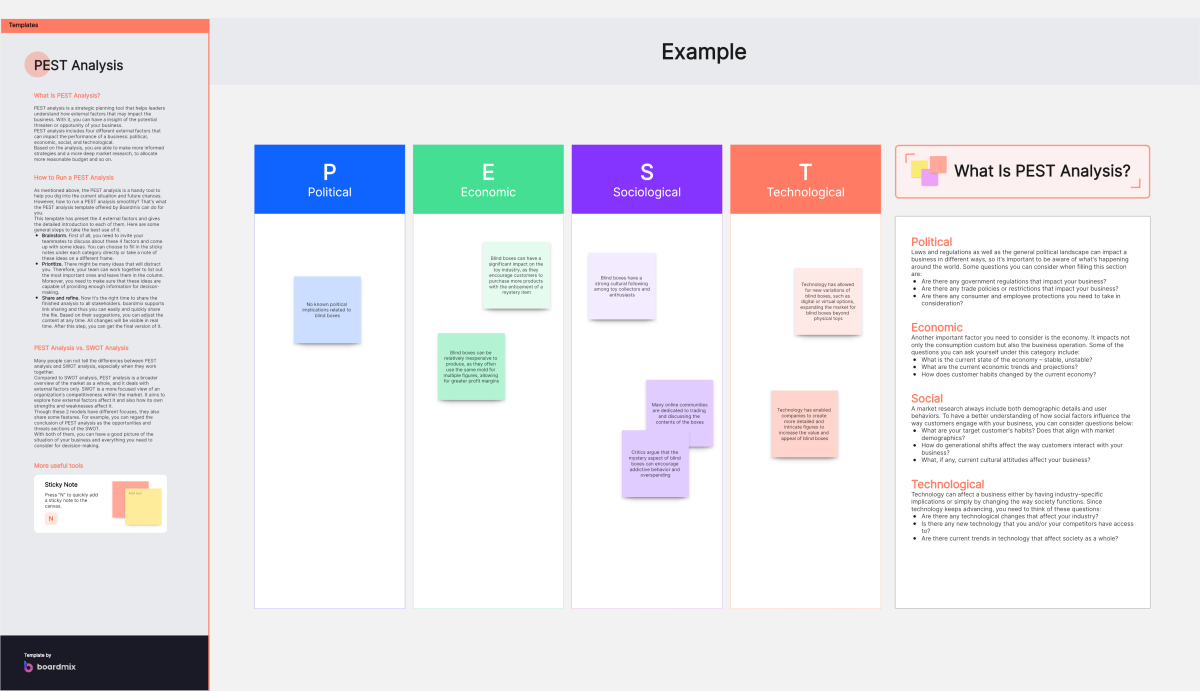
What is PEST Analysis
PEST analysis is a strategic management tool used to analyze and evaluate the external factors affecting an organization or a specific project. The acronym "PEST" stands for Political, Economic, Social, and Technological factors. These factors are assessed to understand the potential opportunities and threats they present to the organization's operations or objectives. PEST analysis helps businesses and decision-makers anticipate changes in their external environment and adapt their strategies accordingly.
What is PEST Analysis used for
PEST Analysis is a macro-environmental analysis that helps businesses understand the external factors that can influence their business environment. It is a component of the broader PESTEL or PESTLE analysis, which also includes Environmental and Legal factors. The PEST framework is particularly useful for:
Strategic Planning: PEST Analysis aids in identifying long-term opportunities and threats that could shape the future direction of a business. By analyzing Political, Economic, Social, and Technological factors, businesses can anticipate changes in the business environment and strategically plan their growth trajectory.
Market Research: Understanding the broader context in which a market operates is crucial for effective market research. PEST Analysis provides this context by offering insights into the external factors that can impact market trends, consumer behavior, and overall market potential.
Risk Management: In terms of risk management, PEST Analysis helps businesses assess potential risks associated with external factors. For instance, changes in government policies (Political), economic downturns (Economic), shifts in consumer attitudes (Social), or rapid technological advancements (Technological) could pose risks. By anticipating these risks, businesses can develop contingency plans to mitigate their impact.
Competitive Analysis: Lastly, PEST Analysis is useful for evaluating how competitors might be affected by the same external factors. This understanding can help businesses identify competitive advantages or vulnerabilities and adjust their strategies accordingly.
Overall, PEST Analysis provides valuable insights that enable businesses to navigate their macro-environment more effectively for strategic planning, market research, risk management, and competitive analysis.
What are the Components of PEST Analysis?
PEST Analysis serves as a powerful tool for businesses to understand the macro-environmental factors that can influence their operations. Each component of PEST Analysis represents a different aspect of the macro-environment. Let's delve deep into its role in strategic planning, market research, risk management, and competitive analysis.
Strategic Planning: PEST Analysis aids in identifying long-term opportunities and threats that could shape the future direction of a business. By analyzing Political, Economic, Social, and Technological factors, businesses can anticipate changes in the business environment and strategically plan their growth trajectory.
Market Research: Understanding the broader context in which a market operates is crucial for effective market research. PEST Analysis provides this context by offering insights into the external factors that can impact market trends, consumer behavior, and overall market potential.
Risk Management: In terms of risk management, PEST Analysis helps businesses assess potential risks associated with external factors. For instance, changes in government policies (Political), economic downturns (Economic), shifts in consumer attitudes (Social), or rapid technological advancements (Technological) could pose risks. By anticipating these risks, businesses can develop contingency plans to mitigate their impact.
Competitive Analysis: Lastly, PEST Analysis is useful for evaluating how competitors might be affected by the same external factors. This understanding can help businesses identify competitive advantages or vulnerabilities and adjust their strategies accordingly.
Whether it's for strategic planning, market research, risk management, or competitive analysis, PEST Analysis provides valuable insights that enable businesses to navigate their macro-environment more effectively.
PEST Analysis Examples for Application
PEST Analysis can provide valuable insights across various industries. Let's look at some examples of how PEST Analysis can be applied in different industries:
PEST Analysis for the Retail Industry
In the retail sector, political factors such as import tariffs and trade policies could significantly impact the cost of goods and ultimately the pricing strategy. Economic factors like consumer spending habits, disposable income levels, and economic stability would directly influence demand patterns. Social trends, including the increasing preference for online shopping or sustainable products, shape consumer behavior. Technological advancements like AI-powered recommendation systems or secure payment technologies also play a crucial role in shaping the retail landscape.
PEST Analysis for the Automotive Industry
For automakers, political factors such as emission regulations or safety standards can dictate design and production decisions. Economic factors like fuel prices or economic downturns can influence consumer buying power and preferences. The shift in social attitudes towards environmentally friendly vehicles has seen a surge in demand for electric vehicles. Technological advancements like autonomous driving technology, electric drivetrains, and connected car technology are reshaping the industry.
PEST Analysis for the Healthcare Industry
In healthcare, political factors like healthcare reforms or policy changes can have a profound impact on how healthcare services are delivered. Economic factors such as public health funding or insurance coverage determine accessibility to healthcare services. Social factors like an aging population or lifestyle trends influence healthcare demand patterns. Technological breakthroughs in areas like telemedicine, AI diagnostics, genomics, and personalized medicine are revolutionizing patient care.
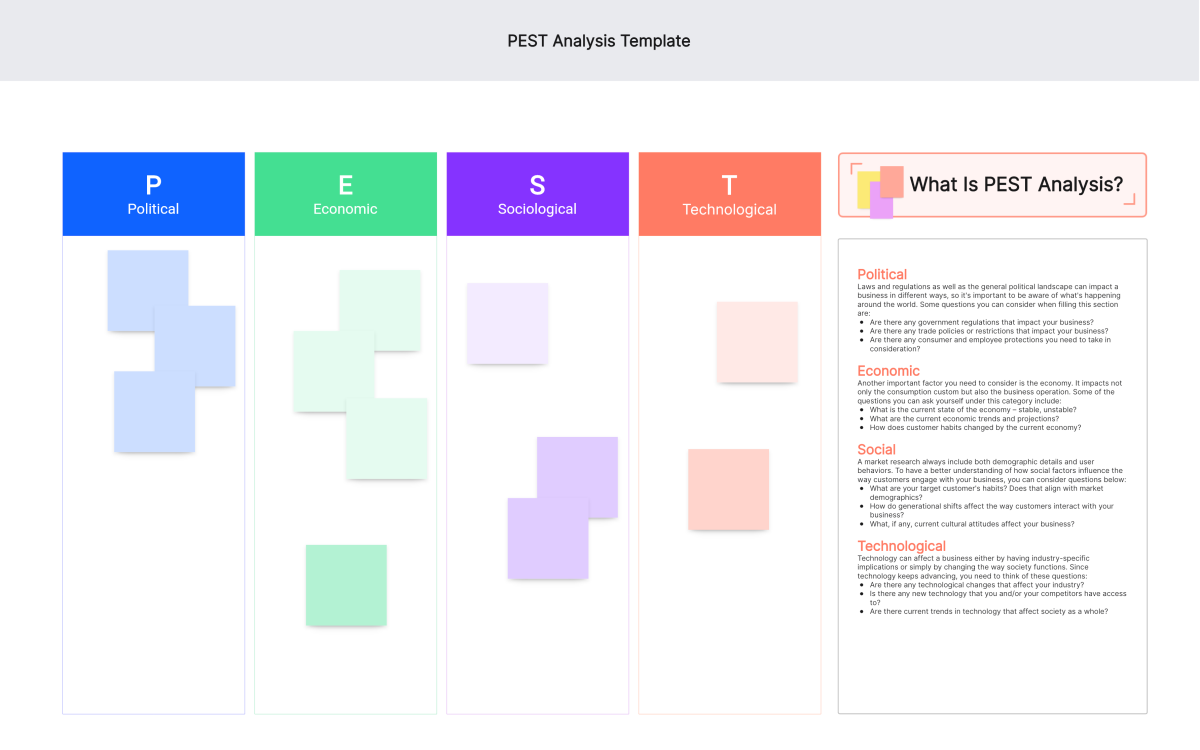
These examples illustrate how PEST Analysis can help businesses in different industries understand their macro-environment better and make strategic decisions accordingly.
How to Conduct a PEST Analysis
Here's a step-by-step guide on how to conduct a PEST analysis.
1. Start by identifying the four key factors that make up a PEST analysis: Political, Economic, Social, and Technological.
2. Political Factors: Analyze the political environment and how it may impact your business. This includes factors such as government stability, regulations, trade policies, and taxation. Look for any political changes or events that may affect your industry or market.
3. Economic Factors: Evaluate the economic factors that can influence your business. Consider factors such as economic growth, inflation rates, interest rates, and exchange rates. Look for any economic trends or patterns that may impact your industry or market.
4. Social Factors: Examine the social factors that can impact your business. This includes factors such as demographic trends, cultural norms, consumer attitudes, and lifestyle changes. Look for any social shifts or movements that may affect your industry or market.
5. Technological Factors: Assess the technological factors that can affect your business. Consider factors such as technological advancements, innovation, automation, and digitalization. Look for any technological developments or disruptions that may impact your industry or market.
6. Gather relevant data and information for each factor. This can be done through market research, industry reports, surveys, and interviews. Ensure that the information collected is accurate and up-to-date.
7. Analyze the data and identify the key opportunities and threats that arise from each factor. This will help you understand the external factors that can impact your business positively or negatively.
8. Prioritize the opportunities and threats based on their potential impact and likelihood of occurrence. This will allow you to focus on the most significant factors and develop strategies to mitigate risks or capitalize on opportunities.
9. Develop an action plan based on the findings of the PEST analysis. This plan should outline specific steps and initiatives to address the identified opportunities and threats. Assign responsibilities and set deadlines to ensure effective implementation.
10. Regularly review and update the PEST analysis to reflect any changes in the external environment. Keep track of new political, economic, social, and technological developments that may impact your business.
By conducting a PEST analysis, you can gain a better understanding of the external factors that can influence your business. This analysis will help you make informed decisions, develop effective strategies, and stay ahead of the competition in a rapidly changing business environment.
Boardmix: Online Whiteboard for PEST analysis
Boardmix Online Whiteboard is a tool that can help users create PEST analysis charts and diagrams. This online whiteboard platform allows users to collaborate and brainstorm ideas in real time. With the PEST analysis in Boardmix, users can easily identify and analyze the political, economic, social, and technological factors that may impact their business or industry.
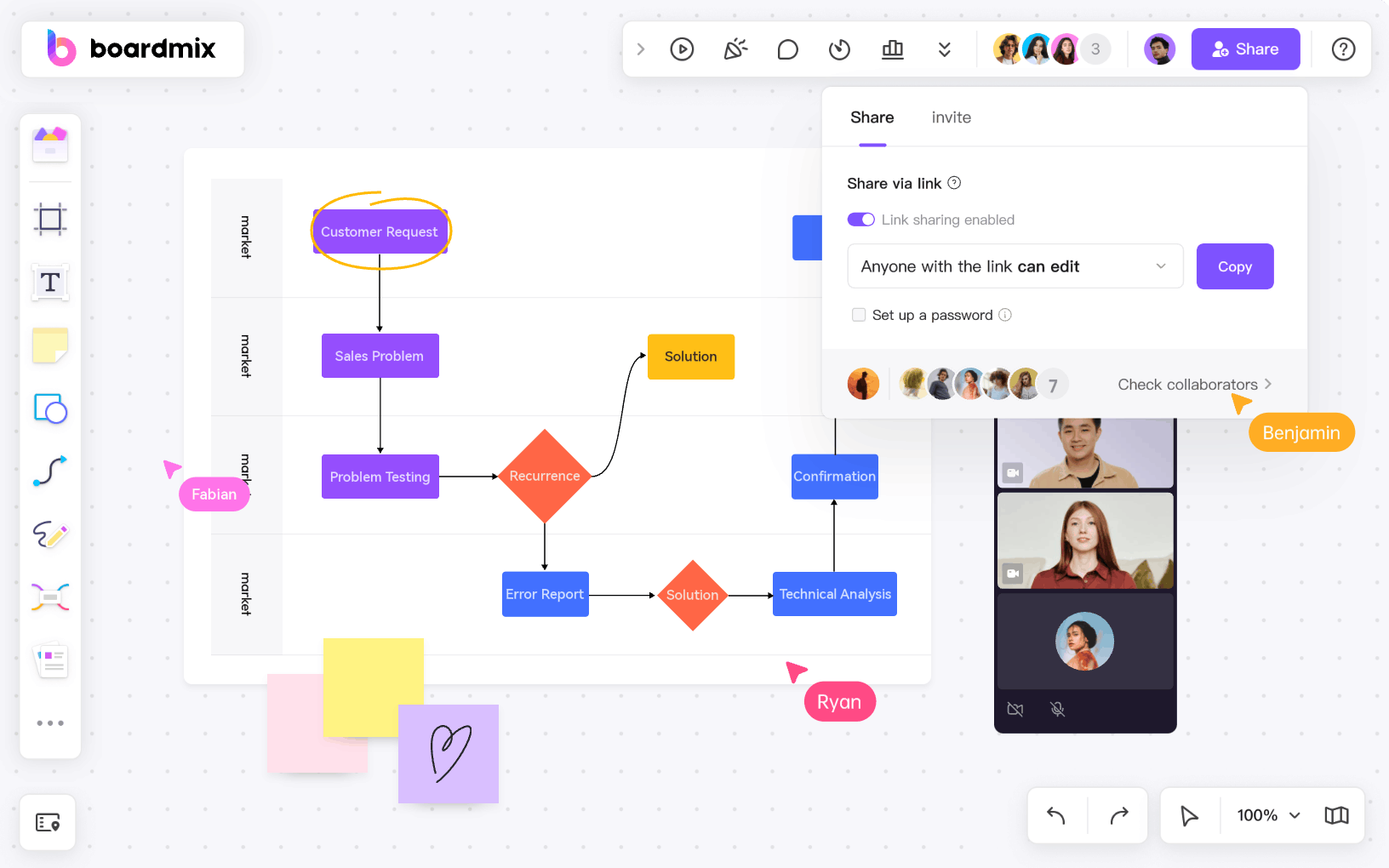
Steps of Creating PEST analysis in Boardmix
Creating a PEST analysis in Boardmix is a straightforward process. Here are the steps to follow:
1. Sign in or create an account: Visit the Boardmix website and sign in with your existing account or create a new one if you don't have an account yet.

2. Create a new whiteboard: Once you're signed in, click on the "New board" button to start creating a new whiteboard for your PEST analysis.

3. Add PEST analysis template: In the whiteboard, click on the "Templates" option in the toolbar and search for "PEST analysis." Select the template that suits your needs and click on it to add it to your whiteboard.
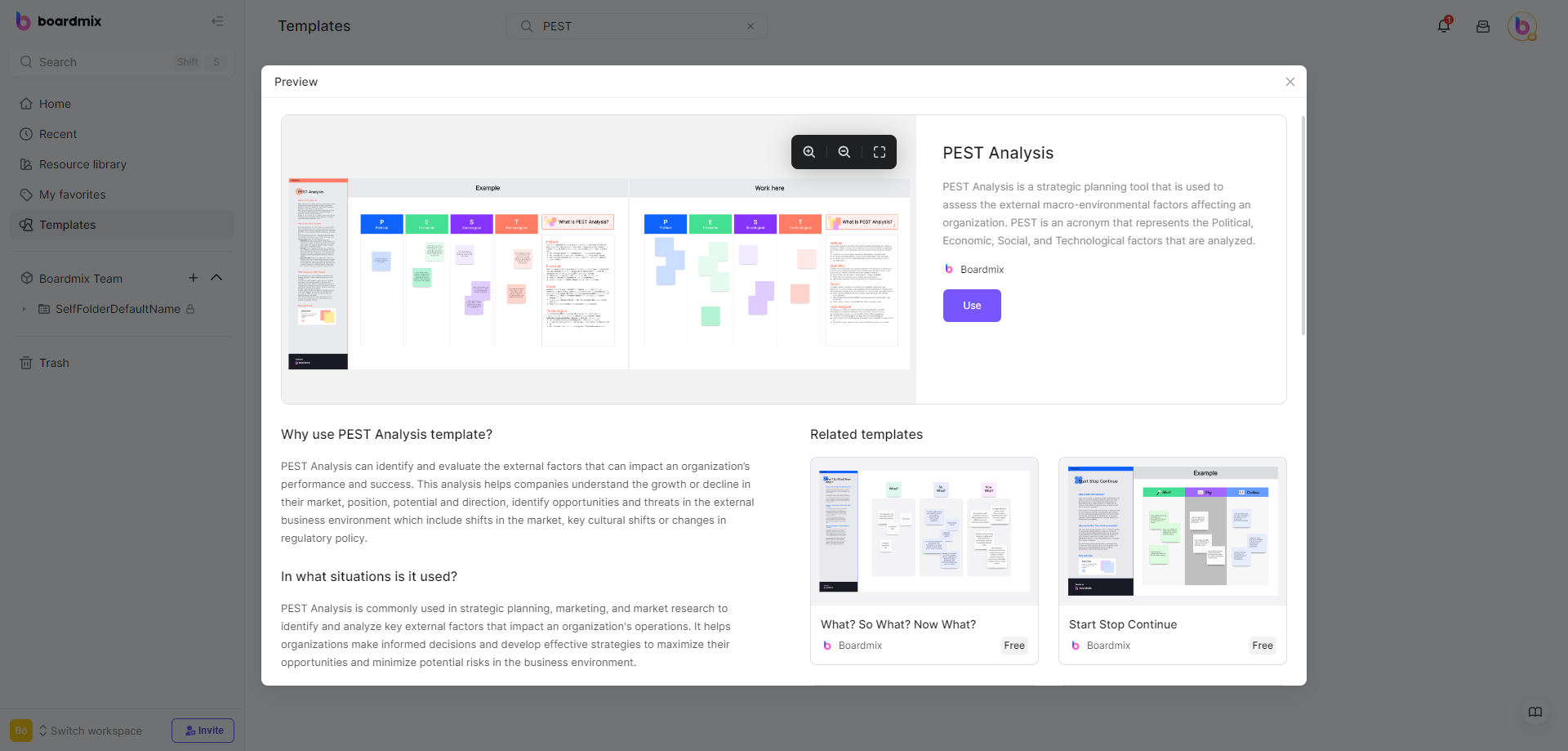
4. Customize the template: Customize the PEST analysis template by adding your own content and data. You can edit the text, add or remove sections, and rearrange elements according to your analysis requirements.
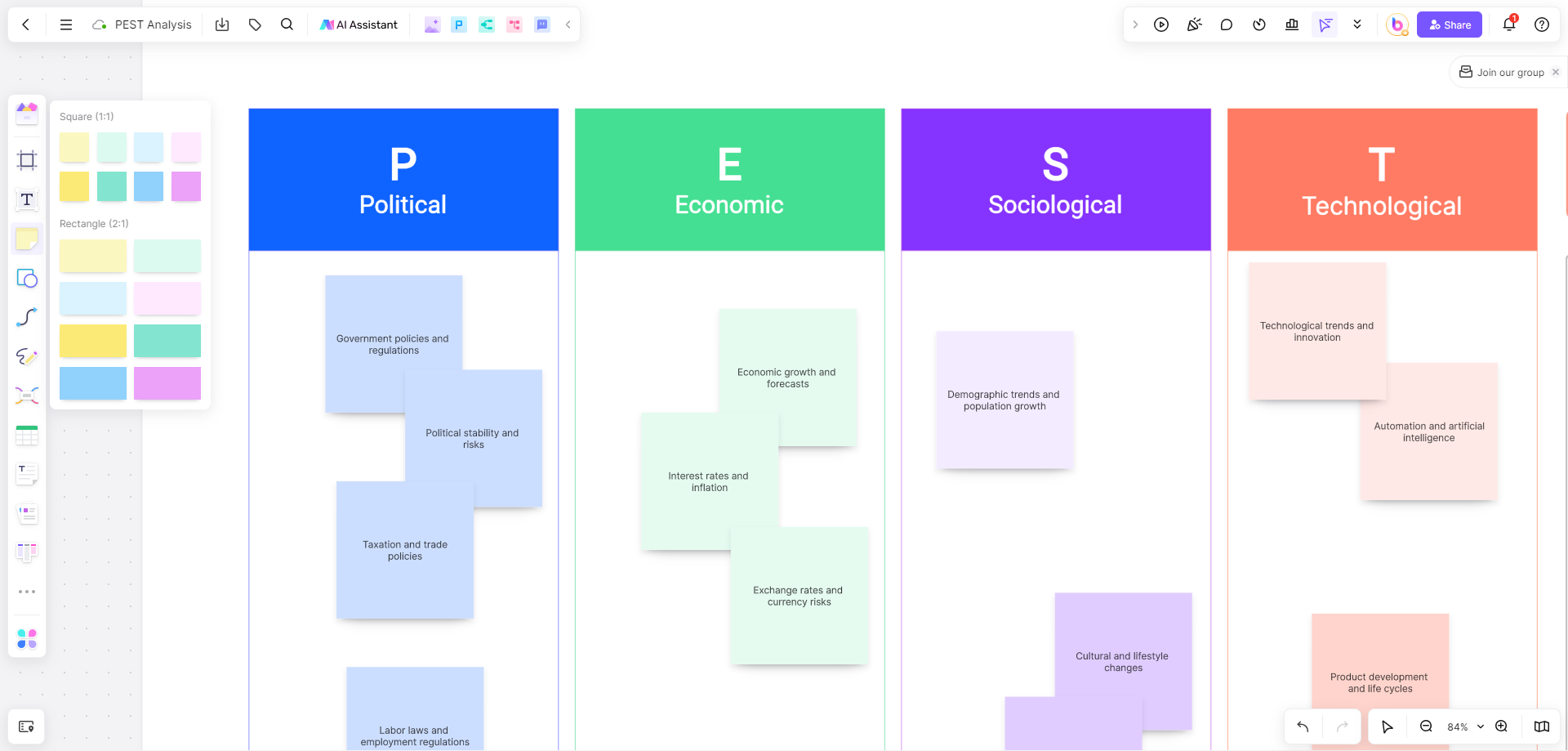
5. Collaborate and gather input: If you're working with a team or stakeholders, use the collaboration features of Boardmix to gather input and insights from others. You can invite team members to join your whiteboard and collaborate in real time.
6. Add notes, comments, and images: Enhance your analysis by adding notes, comments, and images to provide further context and explanations for your findings. This will make your analysis more comprehensive and informative.
7. Export and share: Once your PEST analysis is complete, you can export it in various formats such as PDF or PNG. This allows you to easily share your analysis with colleagues, clients, or other stakeholders.
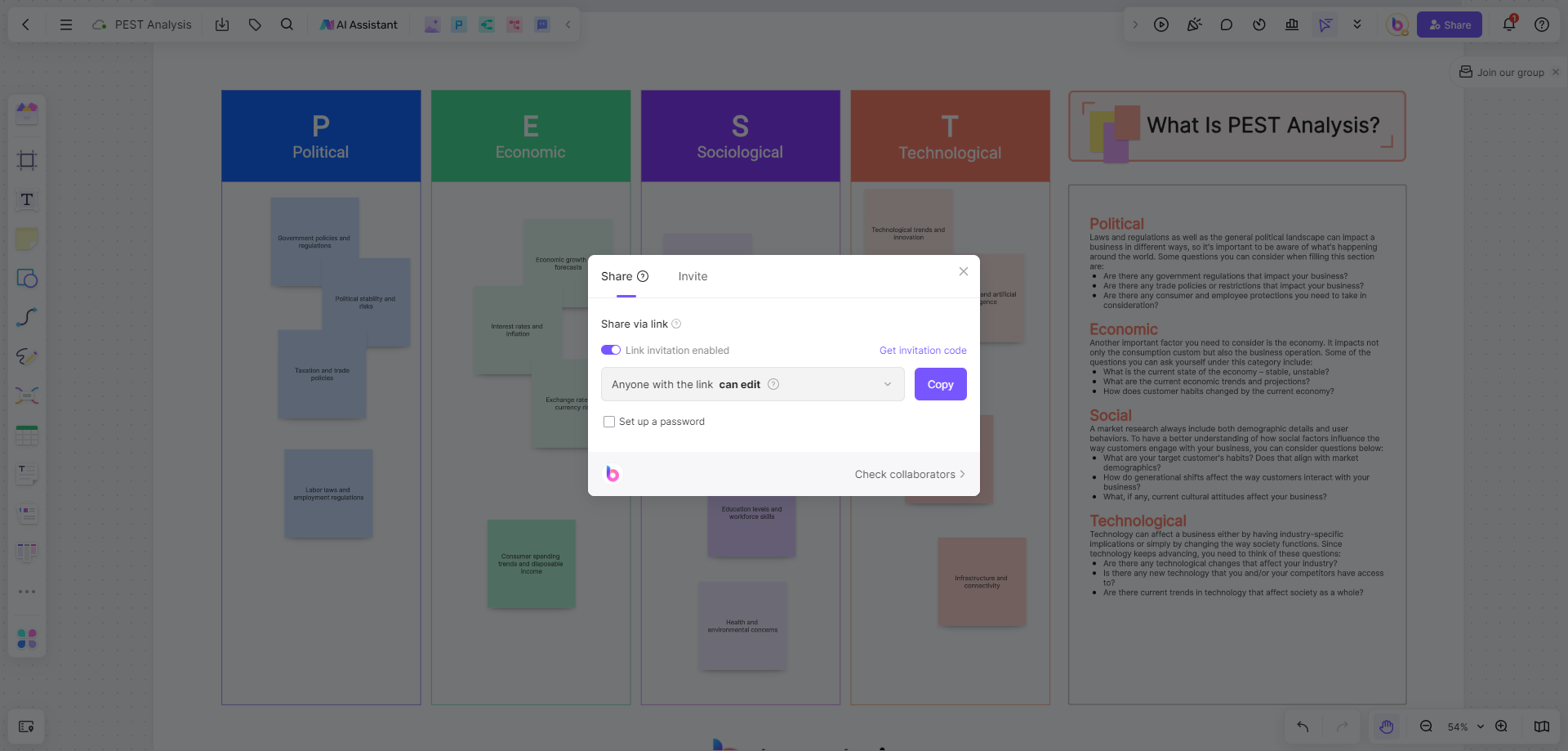
That's it! You have successfully created a PEST analysis in Boardmix. Enjoy exploring and analyzing the external factors that may impact your business or industry.
Why Use Boardmix to Make PEST Analysis?
When it comes to using Boardmix for PEST analysis, several key features make it a valuable tool.
1. Firstly, Boardmix offers a user-friendly interface that makes it easy for users to navigate and create their PEST analysis charts. The platform is designed to be intuitive and user-friendly, ensuring that even those without technical expertise can easily utilize the tool.
2. Secondly, Boardmix provides a wide range of customization options. Users have the ability to choose from various templates and layouts, allowing them to tailor their analysis to their specific needs. Whether you're analyzing the political, economic, social, or technological factors, Boardmix has the flexibility to accommodate your requirements.
3. Furthermore, Boardmix supports real-time collaboration. This means that multiple users can work on the same analysis simultaneously, enabling teams to brainstorm ideas, share insights, and gather input from different perspectives. This collaborative feature enhances the overall effectiveness of the PEST analysis and ensures that all relevant stakeholders have a voice in the process.
4. Additionally, Boardmix allows users to add notes, comments, and images to their analysis. This functionality enables users to provide further context and explanations for their findings, enhancing the clarity and depth of the analysis. The ability to include images also allows for visual representations of data or examples, making the analysis more engaging and informative.
5. Lastly, Boardmix offers a seamless exporting and sharing process. Once the PEST analysis is complete, users can easily export their charts in various formats such as PDF or PNG. This enables them to share their analysis with colleagues, clients, or other stakeholders.
Overall, the features offered by Boardmix make it an ideal choice for conducting a PEST analysis. Its user-friendly interface, customization options, real-time collaboration capabilities, note-taking functionality, and exporting capabilities ensure a comprehensive and efficient analysis process.

PEST Analysis Templates
To help you get started with your own PEST Analysis, here are simplified templates for each component:
1. Political Factors
- Government policies and regulations
- Political stability and risks
- Taxation and trade policies
- Labor laws and employment regulations
2. Economic Factors
- Economic growth and forecasts
- Interest rates and inflation
- Exchange rates and currency risks
- Consumer spending trends and disposable income
3. Social Factors
- Demographic trends and population growth
- Cultural and lifestyle changes
- Education levels and workforce skills
- Health and environmental concerns
4. Technological Factors
- Technological trends and innovation
- Automation and artificial intelligence
- Product development and life cycles
- Infrastructure and connectivity
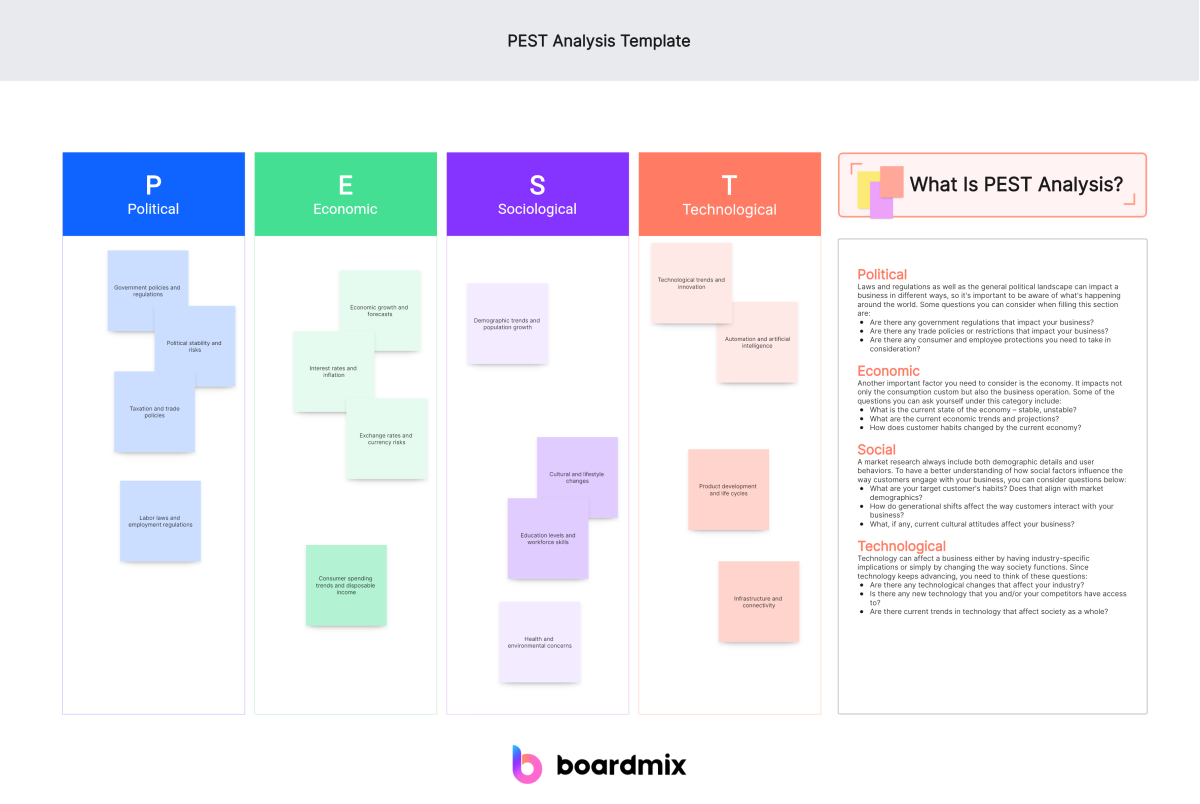
Conclusion
PEST Analysis is a valuable tool for businesses looking to understand and navigate the complex macro-environmental factors that can influence their success. By conducting a thorough PEST Analysis, organizations can gain insights into potential opportunities and threats, allowing them to make informed strategic decisions. The templates provided serve as a starting point, but businesses should tailor their analysis to their specific industry and market context. Boardmix provides a user-friendly interface with various templates and customization options to create visually appealing PEST analysis charts. Users can also add notes, comments, and images to further enhance their analysis. Discover the Boardmix Online Whiteboard for PEST Analysis and conduct a thorough analysis of external environment.








